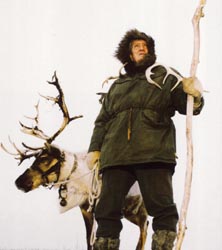 
|
|
|
|

|
 |
 |
Nortel Palm Springs Film Festival
Founded in 1989 by then Mayor Sonny Bono, the Nortel Palm Springs film festival passed its 10th year without completing the transition it’s been so long poised to make: from local diversion in exotic garb to valuable niche outlet for foreign film distribution and buzzmaking.
 |
| Peter Lynch's The Herd. |
Yet, despite its consistently strong and far-reaching survey of world cinema, the festival was redolent with the rarified air of command performance purchased by and for the town’s wealthy visitors and retirees. Festival patrons have proven that they’re willing and able to shell out the funds necessary to mount the festival, even purchasing the future site for a $2 million-dollar festival complex, complete with three screens, a coffee shop and an "Italian street facade." Of course, the festival also provides a practical opportunity for studios and distributors to reach out to voting Academy members who’ve moved to this retirement haven. The opening night awards gala paid tribute to such old-school standbys as Debbie Reynolds and MPAA president Jack Valenti. Audience favorites – the only honor to be obtained at this non-competitive event – tended towards sentimental pictures that arrived with a favorable buzz, including Central Station and Carlos Saura’s Tango. Overall screenings were enjoyed not by swarms of industry seekers and eager talent, but by crowds of silver-haired film buffs.
Typical for the festival was the U.S. premiere of The Herd, the second feature by Peter Lynch, the Canadian director of ’98’s goofy but great documentary Project Grizzly. A lovely, mythically charged piece about the real-life, six-year drive of 3,000 reindeer from the Yukon to the Canadian Northwest territories, the film was shown to an audience of about 30, most of whom were seniors. Lynch, whose film did receive some tentative interest from American distributors at the last Toronto film festival, didn’t seem too put off by the lack of action in Palm Springs. "I don’t get a sense the festival is about that," said the filmmaker cheerfully adding that this visit was less business than "a sort of holiday."
And the festival does make for a fine vacation. Palm Springs director of programming Monica Breckinridge feels the festival’s potential lies partly in the town’s laid back comfort. "What’s great about this location," says Breckinridge, "is that it’s a good time to be here. It’s a very gracious town."
Breckinridge is the fourth programmer the festival has had in 10 years. The former executive director of the Black Filmmaker Foundation and director of development for House Party’s Hudlin Brothers, Breckinridge was hired last October, and had to have a schedule to the printers by the middle of November. It’s a timetable that left little time for courting industry or exploring the festival’s potential. "I think it’s time for them to look at having a programmer year round," Breckinridge says, "It’s important for the identity of the festival to have some consistency." When asked if that programmer might be herself, Breckinridge is cautiously positive. "I think it can be me," she offers, "I see the opportunity here, I have the energy and the credentials for it, and I love films.
-
Sundance Film Festival by Ray Pride
Miami Film Festival by Brandon Judell
New York Underground Film Festival by Michelle Handelman
Thessaloniki International Film Festival by Ray Pride
Alpe Adria Film Festival by Natasha Senjanovicl
Nortel Palm Springs Film Festival by Hazel-Dawn Dumpert
back to top
home page | subscribe | merchandise | history | order form | advertise | contact
archives | links | search
© 2005 Filmmaker Magazine